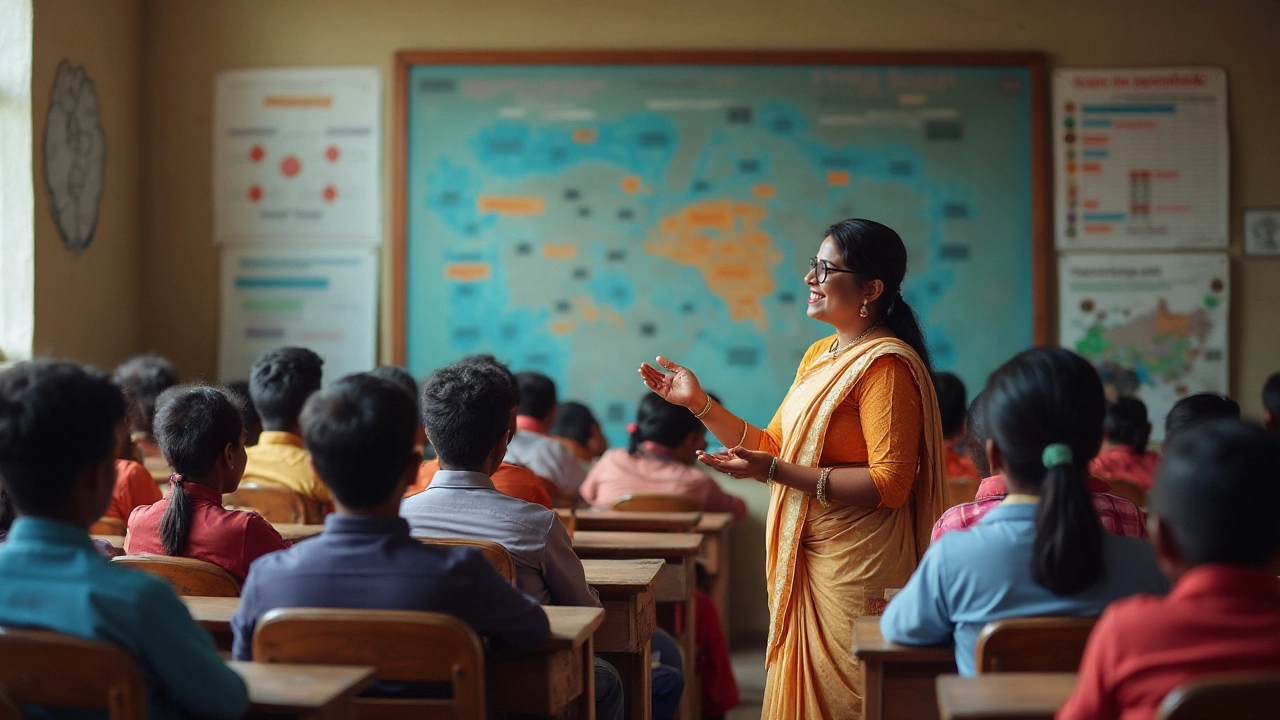India's education system has a rich tapestry of traditions, yet it continues to evolve, accommodating a spectrum of learning paths. Many students and parents often wonder how globally recognized certifications, like the High School Diploma or GED, fit into this landscape.
While these certifications might seem more familiar to an international audience, understanding their equivalence and relevance in India can open up alternative avenues for education and career planning. In this exploration, we'll delve into what these diplomas mean, how they align with the Indian qualifications, and why they might be an option worth considering for students and professionals alike.
Join us on a journey to unravel the intricacies of these qualifications, how they compare with Indian diploma courses, and offer practical guidance for those navigating their educational choices.
- Indian Education System Overview
- What is a High School Diploma?
- GED Explained
- Comparing GED and Indian Diplomas
- Diploma Courses Equivalent in India
- Practical Tips for Choosing the Right Path
Indian Education System Overview
The Indian education system is a vast and intricate network that operates on multiple levels, catering to one of the largest student populations in the world. Governed by both the central and state governments, it is a hierarchical system that begins with pre-primary education and extends to higher education and beyond. At its core, the system emphasizes literacy and numeracy in the early years, progressing towards a more specialized curriculum as students advance. Primary education, which covers children aged 6 to 14, is free and compulsory under the Right to Education Act, highlighting the nation's commitment to universal education.
Secondary education follows, comprising grades 9 to 12, and is split into two stages: lower secondary and upper secondary. Here, students are introduced to a diverse curriculum that includes languages, science, mathematics, social sciences, and vocational subjects. The culmination of secondary education in India is marked by board examinations conducted by various boards like CBSE, ICSE, and state boards. These examinations are pivotal, as their outcomes significantly influence a student's career path, determining eligibility for higher studies and entry into prestigious institutions.
The National Curriculum Framework, a guiding document for Indian education, states, "Education is a unique investment in the present and the future." This sentiment is reflected in how the system strives to balance traditional methods and progressive reforms to cater to changing global demands.
With globalization and technological advancement reshaping the education landscape, there is a growing emphasis on skill-based learning and digital literacy, preparing students for the digital era. This transformation is evident in the rise of MOOCs and e-learning platforms, which complement traditional classroom learning. The introduction of the National Education Policy 2020 marks a significant shift, focusing on multidisciplinary approaches, flexibility, and the re-integration of dropouts into the mainstream. This policy reform aims to make education more holistic and accessible, promoting critical thinking and creativity.
Diploma courses India form an integral part of the higher education system, offering vocational training and specialized skills that align with industry demands. Students who wish for alternatives to mainstream academic pathways often opt for these courses. In fact, institutions like Industrial Training Institutes (ITIs) and Polytechnic Colleges offer diploma programs in fields ranging from engineering to healthcare. These programs are designed to bridge the gap between education and employment, equipping students with practical skills tailored to the needs of the workforce.
What is a High School Diploma?
A high school diploma serves as a symbol of completing secondary education, typically acquired after finishing grades 9 through 12. This credential, widely recognized in countries like the United States and Canada, marks a student's successful navigation through various subjects including mathematics, science, literature, and social studies. The essence of a high school diploma is (often) viewed by students and educators alike as both a rite of passage and a stepping stone to higher education or employment opportunities. This document not only certifies an individual's educational progression but also represents their readiness for the next chapter in life, be it further education or entering the professional world.
In the United States, each state has its own educational standards and graduation requirements, which can include completing a specific number of credits in designated areas alongside satisfactory performance on standardized testing. Achieving a high school diploma often involves a blend of academic coursework, practical projects, and in some cases, vocational training. This education path prepares students with both fundamental skills and critical thinking abilities that are highly valued in higher studies and in various professional arenas. An interesting aspect of the diploma is its diversity in terms of adaptation to different learning styles and needs, whether it’s through traditional brick-and-mortar schools or alternative educational settings like online programs.
"A high school diploma remains one of the most important milestones in a student's educational journey, providing a foundational credential that opens many doors," states Education Week.
From an international perspective, particularly in a country like India, understanding what a high school diploma entails is of great importance for those looking at educational opportunities abroad. For many Indian students, who primarily undergo secondary education based on prescribed curriculums like the CBSE or ICSE, the notion of a high school diploma might differ. The structure and content coverage can vary widely, with the Indian education system placing a strong emphasis on core subjects with rigorous assessment criteria. However, the concept of transferring skills and knowledge to new environments highlights the universal and adaptable nature of a high school education, regardless of geographical boundaries.
When it comes to global employability, having a high school diploma can be crucial. Employers worldwide often consider it a minimum requirement for hiring non-specialized roles. It stands as a testament to the employee's commitment to completing a structured educational path. For Indian students aspiring to join an international workforce or pursue studies in countries recognizing the diploma, it's paramount to grasp its equivalent value and possible transition pathways. This understanding can greatly aid in crafting an effective academic and career strategy that aligns with personal goals and international standards.

What is GED?
The General Educational Development (GED) test has become a well-known alternative to traditional high school diplomas in many countries, and it's increasingly considered by learners in India seeking diverse educational paths. Originally developed in the United States during the 1940s, the GED was created as a means for returning World War II veterans to complete their high school education. However, since then, it has evolved into a tool for anyone needing to demonstrate equivalent academic skills to a high school graduate. Its promise lies in providing a gateway for individuals who, for various reasons, could not complete their conventional schooling journey.
Globally recognized, the GED comprises four main subjects: Mathematical Reasoning, Science, Reasoning Through Language Arts, and Social Studies. Each segment evaluates a specific area of knowledge, ensuring that candidates possess the foundational skills necessary for further education or vocational training. In today’s competitive landscape, the GED is accepted as an alternative credential by more than 97% of colleges and employers in the United States, and its acceptance is growing within India as well. Yet, its integration into the Indian educational system requires adaptability, as learners navigate the nuances between Indian curricula and international standards.
Interestingly, a report by the Ministry of Human Resource Development highlighted how non-traditional education paths, such as the GED, are gaining traction among Indian students looking to study abroad. The GED acts as an equalizer, providing students with an alternative key to unlock educational and career opportunities. With exams available at designated centers globally and increasing online options, the accessibility of the GED is another appealing factor for many.
Why Choose the GED?
Individuals might choose the GED for various reasons, whether driven by personal circumstances, academic challenges, or a desire to pursue studies at their own pace. The flexible nature of preparing for and taking the GED exams makes it an appealing option for those balancing multiple commitments, such as work and family life. The test itself does not require formally attending classes, allowing students to study independently or through flexible GED preparation programs tailored to their schedules and learning styles.
The GED serves a significant purpose beyond academic validation. By providing a certificate documenting one's capabilities equivalent to a high school graduate, it opens doors to employment and higher education avenues that might have been closed otherwise. Many people find that earning a GED can be a powerful confidence booster, a stepping stone to further ambitions, and a narrative changer, spurring individuals toward future success. To quote Amitabh Kumar, a senior education consultant:
"In India, the GED represents more than just a certificate—it is a testament to lifelong learning and personal growth. It mirrors the resilience and adaptability of our learners as they strive for educational parity and excellence."
| GED Component | Subject Area | Skills Tested |
|---|---|---|
| Mathematical Reasoning | Math | Quantitative problem-solving, number operations, algebraic operations |
| Science | Basic Science | Understanding of life science, physical science, earth and space science |
| Reasoning Through Language Arts | Language | Reading comprehension, writing skills, grammar, and editing |
| Social Studies | Social Sciences | Interpretation of historical events, economic principles, and political analysis |
For those exploring the value of a GED in India, it’s essential to consider how its offerings align with their personal and professional goals. As the Indian education landscape continues to adapt to global standards, the GED could be a compelling step for many seeking a second chance at education, a fresh start in their career, or even as an entry point into international universities.
Comparing GED and Indian Diplomas
The landscape of educational credentials and their equivalence is often complex, especially in a country like India, where the traditional high school diploma stands as a pivotal academic milestone. The GED, known as the General Educational Development test, is an alternative that provides individuals who did not complete high school the opportunity to earn credentials akin to a high school diploma. While common in the United States and a few other countries, it is crucial to understand how the GED fits into India's education framework.
In India, the standard path involves completing Class 10 and Class 12 board examinations, followed by higher education pursuits. A recognized high school diploma typically reflects the successful completion of 12th grade, certified by boards like the CBSE (Central Board of Secondary Education), ICSE (Indian Certificate of Secondary Education), or respective state boards. The GED, on the other hand, evaluates skills equivalent to high school level and covers subjects such as mathematical reasoning, science, social studies, and language arts.
It can be challenging for Indian students to directly substitute a GED for these board certifications. Many universities and employers in India are not familiar with the GED, often requiring clarification on its equivalence. An important step for GED holders is to obtain a credential evaluation, a specialized service that assesses and compares international academic documents to Indian standards. This is crucial as education credentials play a significant role when seeking further education or employment in India.
"Understanding the value of a high school diploma or GED in India helps students make informed decisions about their educational journey," commented Dr. Sneha Mehta, an education consultant based in Bangalore.
Moreover, while Indian diplomas focus strongly on rote memorization, the GED emphasizes critical thinking and problem-solving skills, which can offer a comparative advantage in certain academic and professional settings. Students interested in studying abroad may also find the GED advantageous, as it is recognized worldwide; however, those planning careers or studies in India must thoroughly research institutional requirements to avoid any potential pitfalls.
To assist GED holders, institutions sometimes offer bridging courses designed to better align GED academic standards with those recognized in India. These courses often cover important subjects or learning approaches that might not be solely addressed by the GED. For those weighing their options between traditional diplomas and the GED, understanding these nuances is vital. The decision ultimately depends on future goals, whether domestically or internationally driven, emphasizing the importance of choosing pathways that resonate with personal and professional aspirations.
Whether opting for a traditional high school diploma or considering the GED, students must be prepared for the reality of different perceptions and validations across institutions. With proper planning and credential evaluations, students can successfully navigate these complexities, using their certificates to unlock opportunities in their educational and career journeys.

Diploma Courses Equivalent in India
When examining the educational landscape in India, one might ask how alternative qualifications like the GED stack up against traditional paths. In the Indian context, formal schooling typically results in completion of the 12th grade, also known as the Higher Secondary Certificate (HSC) or an equivalent from varied educational boards such as CBSE or ICSE. Yet, not everyone follows this path. For those looking for a non-traditional route, various diploma courses offer a comparable level of education and can be a viable option for post-secondary advancement.
These diploma courses can be found in government-recognized polytechnic institutions across India. They often focus on vocational and practical skills, covering areas like engineering, technology, design, and healthcare. These programs usually run for three years post-10th grade, which aligns well with international standards and can sometimes be seen as parallel to a high school diploma or GED certification. One may wonder why to consider these diplomas. The answer lies in the flexibility and special focus these courses offer. They often emphasize hands-on learning and provide an array of opportunities in technical fields, sometimes enabling students direct entry into the workforce.
A popular choice is the engineering diploma, particularly in mechanical, civil, electronic, or computer engineering. Such programs are rigorous and prepare students for both employment and further studies, such as a Bachelor's degree in engineering. It's noteworthy how these diploma curriculums are structured: Two semesters per year with a mix of theory, practicals, and at times, industrial training, which significantly bolsters the job prospects for graduates.
If you're wondering about their acceptance, many corporations and universities in India recognize these diplomas as on par with a formal high school education. An alumnus from a leading Delhi polytechnic asserted,
Diploma courses equip you with industry-ready skills, offering not just an educational credential but a pathway to a career.This acknowledgement highlights the practical benefits of pursuing such diplomas.
Interestingly, as the Indian education system evolves, hybrid models and international tie-ups have become more common. Some institutions offer diplomas alongside international certifications like A-Levels, which may further enhance their educational credentials footprint. When dissecting job placements, there's a positive trend with diplomas holding a significant stake in employment statistics. A survey from the National Skill Development Corporation indicates that over 40% of diploma holders secure jobs within six months of graduation.
Practical Tips for Choosing the Right Path
Choosing the right path when balancing between a traditional high school diploma or a GED in India involves thoughtful consideration tailored to each student's unique aspirations and circumstances. Firstly, understanding one's personal and professional goals is paramount. Students must reflect on their career objectives, preferred learning styles, and the kind of work-life balance they envision. It's akin to crafting a roadmap where the end destination influences the route. While some might prefer the structured environment of traditional schooling, others may thrive in the more flexible GED setup, allowing them to pursue parallel interests or engagements. Considering the global recognition of a GED, especially for those aiming to study or work abroad, can also be a decisive factor.
When navigating these choices, one should weigh the societal perceptions and the practicality of these certifications within India. The educational ethos here places considerable importance on conventional examination systems. However, the dynamic nature of today's job market and educational landscape suggests a rising acceptance of alternative pathways. Delving deeper into career outlooks and educational prospects, consulting with educational advisors, or seeking guidance from mentors can provide invaluable insights. In India, certain universities and colleges might have specific prerequisites or preferences, making it essential to verify these requirements during one's research. Successful alumni stories can often serve as motivational examples for potential paths to take.
A strategic approach could entail making a pros and cons list, juxtaposing the advantages of each option. Attention should be given to the kind of study environment one is comfortable in, the peer group interactions, and available support systems. Financial considerations also come into play. While traditional schooling may have varied fees, GED preparation might necessitate investing in specialized courses or materials. Discussing these factors with family members can also provide a rounded perspective, ensuring that personal desires align with familial expectations, which often play a significant role in the Indian context.
"Education is the most powerful weapon which you can use to change the world." - Nelson Mandela
Moreover, one must stay informed about scholarship opportunities. Various organizations and educational institutions offer financial assistance for students who demonstrate exceptional potential. This can significantly ease the financial burden and open doors to unparalleled opportunities. Joining student forums or online groups can also offer peer support, helping one get real-time experiences and tips. These platforms serve as conducive spaces for sharing insights about academia and address queries vividly, fostering a community-driven exploration of prospects. As the society becomes more integrated with digital paradigms of learning and working, understanding and leveraging online resources becomes a vital part of making an informed decision.
Lastly, embracing flexibility and being open to adjustments is crucial. Sometimes, the path we start on might need recalibration, and changing directions is entirely plausible and commendable. The future of work and education urges adaptability, making it a worthwhile trait to develop during one’s educational journey. These choices should not be seen as isolated decisions but as an ongoing process that evolves with time, equipping one to face the ever-changing dynamics of the global scene.
